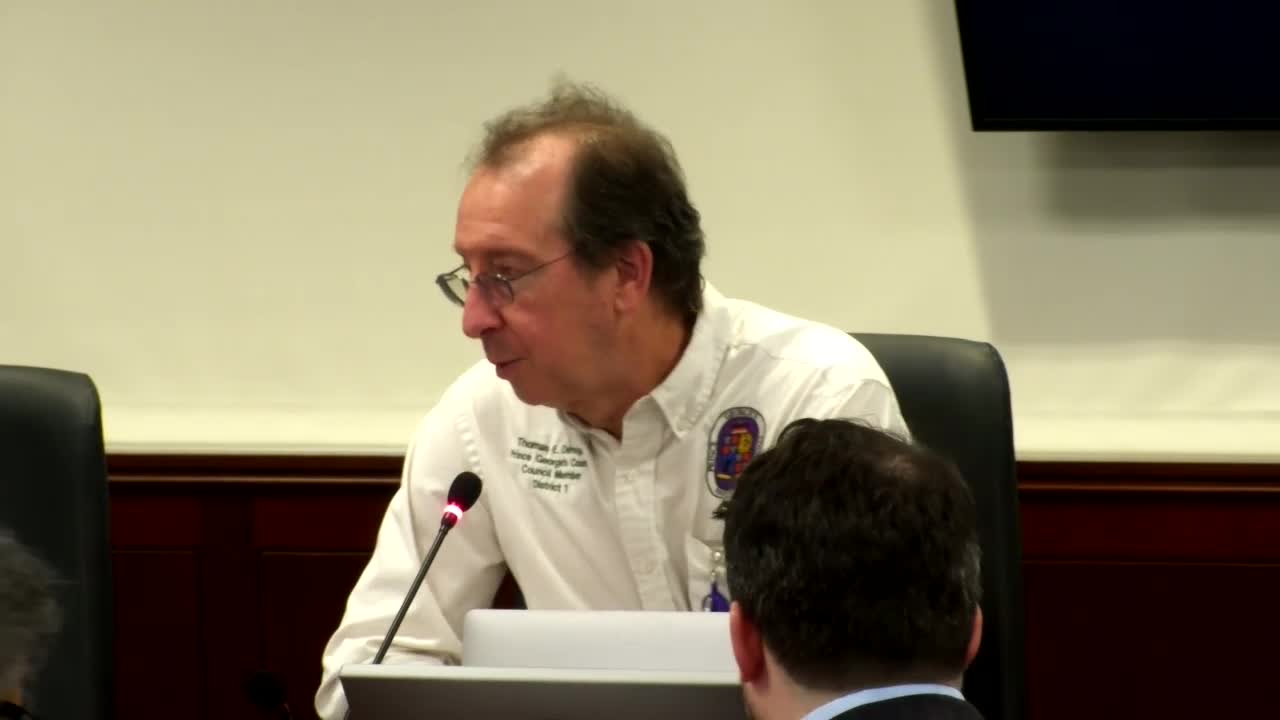Task force reviews draft legislation to change police facility adequacy in subdivision regulations
April 14, 2025 | Prince George's County, Maryland
This article was created by AI summarizing key points discussed. AI makes mistakes, so for full details and context, please refer to the video of the full meeting. Please report any errors so we can fix them. Report an error »

Members of the Prince George's County Plan 2035 Implementation & Infrastructure Task Force on April 14 reviewed draft legislation prepared by the acting county executive that would amend how police facility adequacy is handled in the county's subdivision regulations.
Planning staff described the draft as a high-level update that would repeal portions of the existing adequacy-review language and defer mitigation for police impacts to other development-review processes and impact fees. Staff told the task force they have reviewed the draft with the acting county executive's office and the police department and that a fiscal impact study being prepared by a consultant will resume in June to provide additional data and methodology for implementation.
Task force members and staff discussed the policy implications. Katina Schoellers, division chief with the planning department, summarized a recommended policy change described elsewhere in the package—including an approach to level-of-service thresholds within transit-oriented development areas that would lower or eliminate traditional roadway level-of-service tests in favor of pedestrian- and multimodal-oriented measures. Schoellers also described coordination with police and other county departments about methodology and data needed to assess response times and adequacy.
Planning staff said the draft legislation's intent is to remove the adequacy review tied to developer mitigation fees and rely on existing impact-fee mechanisms. Staff also noted a 2005 resolution that previously provided guidelines for mitigation and that the department has compared regional practices and found few, if any, jurisdictions that currently tie police response-time tests to development review in the same way. A task force member cited comparisons to other jurisdictions (Montgomery County and Annapolis were discussed) but staff said variation among jurisdictions makes direct comparisons difficult.
Members raised practical concerns: several noted current police staffing shortfalls and asked whether development pace should be slowed in areas lacking personnel. Staff said the fiscal impact study and additional data on police response-time trends will inform that assessment and recommended that the task force seek a follow-up briefing from the county executive's office on current staffing and response-time projections. The consultant-led fiscal impact study will resume in the summer and is intended to collect historical police response data and other metrics.
No formal vote or ordinance adoption occurred at the meeting; staff asked the task force to review the draft and said they will return with further analysis once the fiscal-impact consultant resumes work in June. Task force members agreed to continue discussion and to provide comments as staff circulates an updated draft for review; the task force planned to finalize a separate draft report on May 19 (per the meeting timeline).
Planning staff described the draft as a high-level update that would repeal portions of the existing adequacy-review language and defer mitigation for police impacts to other development-review processes and impact fees. Staff told the task force they have reviewed the draft with the acting county executive's office and the police department and that a fiscal impact study being prepared by a consultant will resume in June to provide additional data and methodology for implementation.
Task force members and staff discussed the policy implications. Katina Schoellers, division chief with the planning department, summarized a recommended policy change described elsewhere in the package—including an approach to level-of-service thresholds within transit-oriented development areas that would lower or eliminate traditional roadway level-of-service tests in favor of pedestrian- and multimodal-oriented measures. Schoellers also described coordination with police and other county departments about methodology and data needed to assess response times and adequacy.
Planning staff said the draft legislation's intent is to remove the adequacy review tied to developer mitigation fees and rely on existing impact-fee mechanisms. Staff also noted a 2005 resolution that previously provided guidelines for mitigation and that the department has compared regional practices and found few, if any, jurisdictions that currently tie police response-time tests to development review in the same way. A task force member cited comparisons to other jurisdictions (Montgomery County and Annapolis were discussed) but staff said variation among jurisdictions makes direct comparisons difficult.
Members raised practical concerns: several noted current police staffing shortfalls and asked whether development pace should be slowed in areas lacking personnel. Staff said the fiscal impact study and additional data on police response-time trends will inform that assessment and recommended that the task force seek a follow-up briefing from the county executive's office on current staffing and response-time projections. The consultant-led fiscal impact study will resume in the summer and is intended to collect historical police response data and other metrics.
No formal vote or ordinance adoption occurred at the meeting; staff asked the task force to review the draft and said they will return with further analysis once the fiscal-impact consultant resumes work in June. Task force members agreed to continue discussion and to provide comments as staff circulates an updated draft for review; the task force planned to finalize a separate draft report on May 19 (per the meeting timeline).
View full meeting
This article is based on a recent meeting—watch the full video and explore the complete transcript for deeper insights into the discussion.
View full meeting
